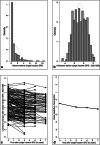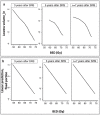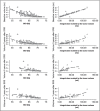Biologically effective dose correlates with linear tumor volume changes after upfront single-fraction stereotactic radiosurgery for vestibular schwannomas
- PMID: 33839944
- PMCID: PMC8592970
- DOI: 10.1007/s10143-021-01538-w
Biologically effective dose correlates with linear tumor volume changes after upfront single-fraction stereotactic radiosurgery for vestibular schwannomas
Abstract
Vestibular schwannomas (VSs) are benign, slow-growing tumors. Management options include observation, surgery, and radiation. In this retrospective trial, we aimed at evaluating whether biologically effective dose (BED) plays a role in tumor volume changes after single-fraction first intention stereotactic radiosurgery (SRS) for VS. We compiled a single-institution experience (n = 159, Lausanne University Hospital, Switzerland). The indication for SRS was decided after multidisciplinary discussion. Only cases with minimum 3 years follow-up were included. The Koos grading, a reliable method for tumor classification was used. Radiosurgery was performed using Gamma Knife (GK) and a uniform marginal prescription dose of 12 Gy. Mean BED was 66.3 Gy (standard deviation 3.8, range 54.1-73.9). The mean follow-up period was 5.1 years (standard deviation 1.7, range 3-9.2). The primary outcome was changes in 3D volumes after SRS as function of BED and of integral dose received by the VS. Random-effect linear regression model showed that tumor volume significantly and linearly decreased over time with higher BED (p < 0.0001). Changes in tumor volume were also significantly associated with age, sex, number of isocenters, gradient index, and Koos grade. However, the effect of BED on tumor volume change was moderated by time after SRS and Koos grade. Lower integral doses received by the VSs were inversely correlated with BED in relationship with tumor volume changes (p < 0.0001). Six (3.4%) patients needed further intervention. For patients having uniformly received the same marginal dose prescription, higher BED linearly and significantly correlated with tumor volume changes after SRS for VSs. BED could represent a potential new treatment paradigm for patients with benign tumors, such as VSs, for attaining a desired radiobiological effect. This could further increase the efficacy and decrease the toxicity of SRS not only in benign tumors but also in other SRS indications.
Keywords: Biologically effective dose; Gamma Knife; Radiosurgery; Tumor; Vestibular schwannoma; Volume.
© 2021. The Author(s).
Conflict of interest statement
The authors declare no competing interests.
Figures




Comment in
-
Biologically effective dose correlates with linear tumour volume changes after upfront single-fraction stereotactic radiosurgery for vestibular schwannomas.Neurosurg Rev. 2022 Jun;45(3):2493-2495. doi: 10.1007/s10143-022-01769-5. Epub 2022 Mar 15. Neurosurg Rev. 2022. PMID: 35290549 No abstract available.
Similar articles
-
Long-term results of upfront, single-session Gamma Knife radiosurgery for large cystic vestibular schwannomas.Neurosurg Rev. 2022 Dec 6;46(1):2. doi: 10.1007/s10143-022-01911-3. Neurosurg Rev. 2022. PMID: 36471101
-
The longitudinal volumetric response of vestibular schwannomas after Gamma Knife radiosurgery.J Neurosurg. 2022 Sep 9;138(5):1273-1280. doi: 10.3171/2022.7.JNS22812. Print 2023 May 1. J Neurosurg. 2022. PMID: 36087328
-
Gamma Knife radiosurgery for large vestibular schwannomas greater than 3 cm in diameter.J Neurosurg. 2018 May;128(5):1380-1387. doi: 10.3171/2016.12.JNS161530. Epub 2017 Jul 14. J Neurosurg. 2018. PMID: 28707997
-
Congress of Neurological Surgeons Systematic Review and Evidence-Based Guidelines on the Role of Radiosurgery and Radiation Therapy in the Management of Patients With Vestibular Schwannomas.Neurosurgery. 2018 Feb 1;82(2):E49-E51. doi: 10.1093/neuros/nyx515. Neurosurgery. 2018. PMID: 29309637
-
Malignant transformation in vestibular schwannoma: report of a single case, literature search, and debate.J Neurosurg. 2014 Dec;121 Suppl:160-6. doi: 10.3171/2014.7.GKS141311. J Neurosurg. 2014. PMID: 25434949 Review.
Cited by
-
MatBED_B&C: A 3-dimensional biologically effective dose analytic approach for the retrospective study of gamma knife radiosurgery in a B&C model.MethodsX. 2023 Aug 5;11:102320. doi: 10.1016/j.mex.2023.102320. eCollection 2023 Dec. MethodsX. 2023. PMID: 37601290 Free PMC article.
-
Impact of biologically effective dose on tremor decrease after stereotactic radiosurgical thalamotomy for essential tremor: a retrospective longitudinal analysis.Neurosurg Rev. 2024 Jan 31;47(1):73. doi: 10.1007/s10143-024-02296-1. Neurosurg Rev. 2024. PMID: 38296852 Free PMC article.
-
Reply to the letter to the editor regarding "Biologically effective dose for vestibular schwannomas: the truth and nothing but the truth".Neurosurg Rev. 2022 Jun;45(3):2497-2498. doi: 10.1007/s10143-022-01804-5. Neurosurg Rev. 2022. PMID: 35513738 No abstract available.
-
Dynamics of tumor evolution after Gamma Knife radiosurgery for sporadic vestibular schwannoma: Defining volumetric patterns characterizing individual trajectory.Neuro Oncol. 2025 Feb 10;27(2):545-556. doi: 10.1093/neuonc/noae187. Neuro Oncol. 2025. PMID: 39283980 Free PMC article.
-
Single fraction and hypofractionated radiosurgery for perioptic meningiomas-tumor control and visual outcomes: a systematic review and meta-analysis.Neurosurg Rev. 2023 Oct 28;46(1):287. doi: 10.1007/s10143-023-02197-9. Neurosurg Rev. 2023. PMID: 37897519
References
-
- Balossier A, Tuleasca C, Cortet-Rudelli C, Soto-Ares G, Levivier M, Assaker R, Reyns N (2020) Gamma Knife radiosurgery for acromegaly: evaluating the role of the biological effective dose associated with endocrine remission in a series of 42 consecutive cases. Clin Endocrinol. 10.1111/cen.14346 - PubMed
-
- Bowden G, Cavaleri J, Iii EM, Niranjan A, Flickinger J, Lunsford LD (2017) Cystic vestibular schwannomas respond best to radiosurgery. Neurosurgery. 10.1093/neuros/nyx027 - PubMed
-
- Fortnum H, O’Neill C, Taylor R, Lenthall R, Nikolopoulos T, Lightfoot G, O’Donoghue G, Mason S, Baguley D, Jones H, Mulvaney C (2009) The role of magnetic resonance imaging in the identification of suspected acoustic neuroma: a systematic review of clinical and cost effectiveness and natural history. Health Technol Assess 13:iii-iv, ix-xi, 1–154. 10.3310/hta13180 - PubMed
MeSH terms
Grants and funding
LinkOut - more resources
Full Text Sources
Other Literature Sources
Medical

